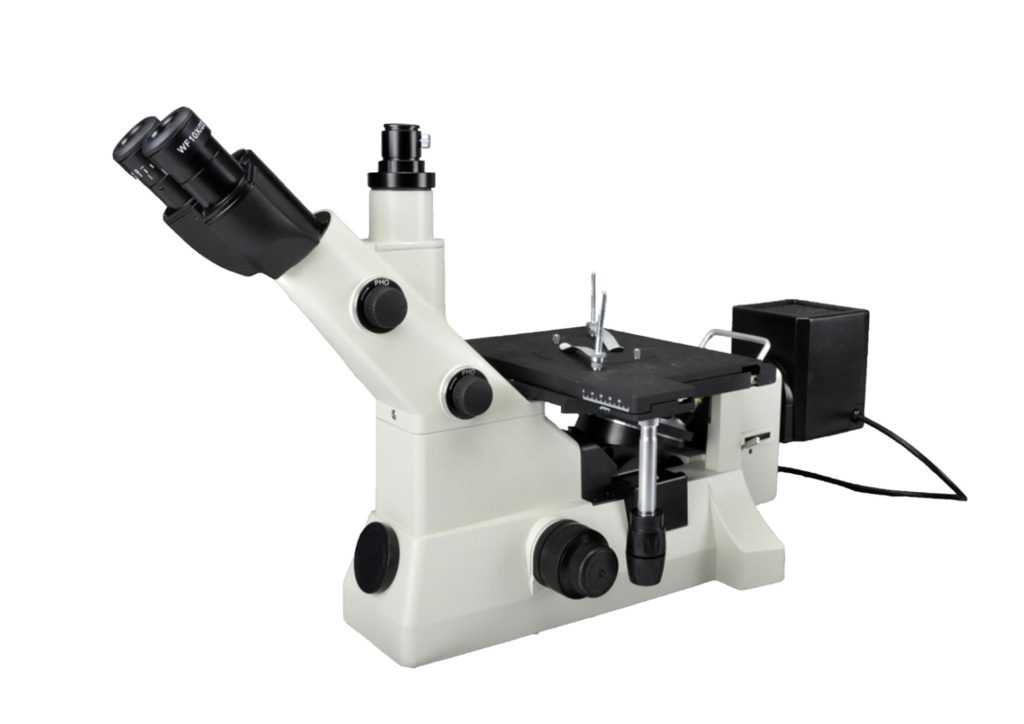Definition of Metallurgical Microscope
The metallurgical microscope system combines traditional optical microscopes with computers (digital cameras) through photoelectric conversion. It not only allows microscopic observation through the eyepiece but also enables real-time dynamic image observation on the computer (digital camera) display screen. Computer-based metallurgical microscopes can also edit, save, and print the required images.
Components of Metallurgical Microscope System
Computer-based Metallurgical Microscope:
- Metallurgical Microscope
- Adapter Mirror
- Camera (CCD)
- A/D (Image Acquisition)
- Computer
Digital Camera-based Metallurgical Microscope:
- Metallurgical Microscope
- Adapter Mirror
- Digital Camera
Differences between Upright and Inverted Metallurgical Microscopes
Metallurgical microscopes can be either upright or inverted. Upright metallurgical microscopes produce upright images, providing great convenience for observation and identification. They are widely used for transparent, translucent, or opaque substances, making them suitable for analyzing and identifying metal samples with heights of 20-30mm. They are commonly used for observing targets between 3 micrometers and 20 micrometers, such as metal ceramics, electronic chips, printed circuits, LCD substrates, films, fibers, granular objects, coatings, and other materials’ surface structures and traces, yielding excellent imaging results.
Inverted metallurgical microscopes use optical plane imaging to identify and analyze the organizational structure of various metals and alloys. They are crucial tools for metallographic research in metal physics, widely applied in factories or laboratories for casting quality inspection, raw material testing, or research and analysis of material metallographic organization after processing. Inverted metallurgical microscopes provide intuitive analysis results and are key equipment for quality identification and analysis in casting, smelting, and heat treatment in the mining, metallurgy, manufacturing, and machining industries.
In inverted metallurgical microscopes, the observation surface of the sample coincides with the worktable surface, and the objective lens is located below the worktable for upward observation. This design is not limited by the height of the sample, making it convenient to use. The instrument has a compact structure, elegant appearance, a large supporting area on the base, a low center of gravity, and is safe, stable, and reliable. The eyepiece and supporting surface are inclined at 45 degrees for comfortable observation.
Applications of Inverted Metallurgical Microscopes
Inverted microscopes are widely used in the steel, automotive, electronics, and other manufacturing industries. They are used for testing polished metal and sliced samples by simply placing the sample upside down on the stage. The sample bottom does not require flat processing, and it can be thick, large, or heavy.
Performance characteristics of MR5000 inverted metallographic microscope

High-performance optical system, simple operation, innovative technology, comprehensive functions, good stability, and the ability to meet various application needs now and in the future. It can be flexibly upgraded, such as easily achieving DIC observation.
Technical Specifications of MR5000 Inverted Metallurgical Microscope
| Optical System | Infinite Distance System, Total Magnification 50X-2000X |
| Super Wide Field Eyepiece | WF10X/22 |
| WF10X/20, Cross-line Eyepiece | |
| WF15X/16 | |
| WF20X/12 | |
| Infinite Long Working DistanceFlat Field Achromatic Objectives | 5X/0.12/∞/0(BF/DF) LWD 10mm |
| 10X/0.25/∞/0(BF/DF) LWD 10mm | |
| 20X/0.4/∞/0(BF/DF) LWD 5mm | |
| 50X/0.75/∞/0(BF/DF) LWD 1.3mm | |
| 100X/0.9/∞/0(BF/DF) LWD 0.7mm | |
| Observation Head | Hinged Binocular Observation Head, Inclined at 30°, Pupil Distance 48-75mm, with two digital channels, capable of simultaneously connecting two cameras, beam splitter ratio R:T=50:50; R:T=100:0/100: |
| Kohler Illumination | 12V/50W Halogen Lamp, Pre-set Center, Continuously Adjustable Brightness |
| Polarizer, Analyzer | |
| Differential Interference Contrast (DIC) | |
| Built-in Revolving Disk with 5 filters: Green, Blue, Yellow, Gray, and Frosted Glass | |
| Focusing System | Coaxial Coarse and Fine Focus, Fine Adjustment Graduation 2μm, Coarse Adjustment Tension Adjustment, Vertical Movement Range 1mm Upward, 7mm Downward |
| Converter | Backward quintuple nosepiece |
| Stage | Rectangular Double-layer Movable Platform 226X178mm, Movement Range 40mmX40mm |
| Small Platform: Φ20, Φ30, Droplet-shaped | |
| Accessories | Photography AccessoriesObjective Micrometer 0.01mm |